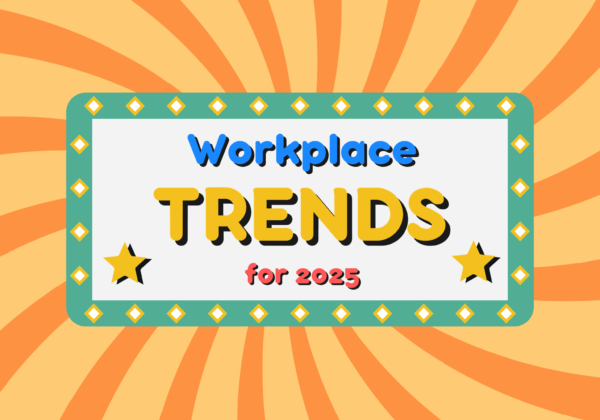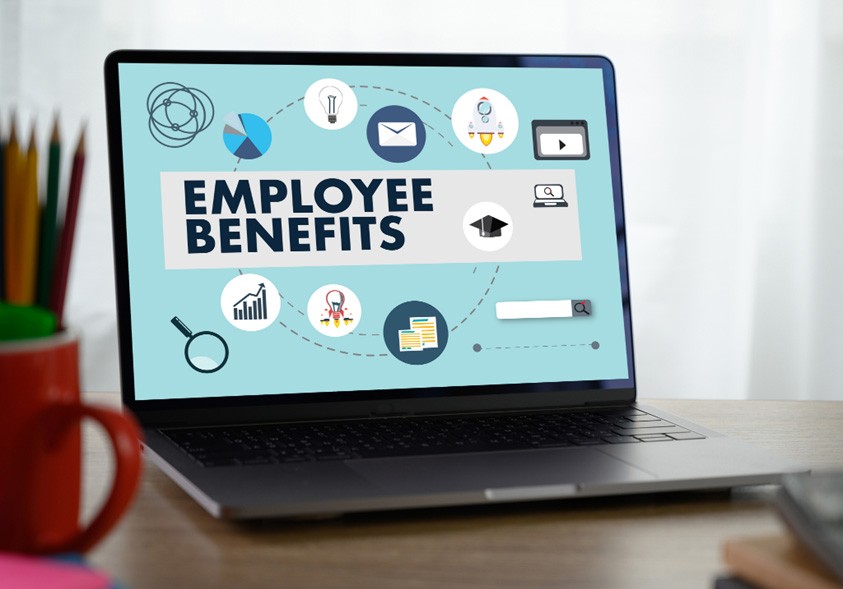🏢 9,000+ Organisations
🏆 6 x L&D/HR Awards
⭐ 4.8/5 Highly Rated
🧠 24 Years' Experience

Workplace trends are redefining how we work and succeed.
Ever heard of ‘quiet quitting’? What about ‘bare minimum Mondays’ or ‘lazy girl jobs’?
Dozens of new workplace trends have popped up over recent years – some starting important conversations and driving real change in the industry, and some being more controversial in nature.
With this in mind, we analysed 50+ workplace trends that have appeared over recent years in a bid to predict which areas will continue to grow, as well as which themes might be part of the next big changes to workplace culture.
Our analysis included desk research, looking at which workplace trends have been covered in the media, as well as looking at popular social media posts (across LinkedIn and TikTok [#worktok]), and then reviewing any commonalities.
We have split the research into six sections:
Read on to discover the highlights from our research, including existing trends, predictions, and commentary.
There are laws in place – sometimes called the ‘working time directive’ or ‘working time regulations’ – that stipulate maximum weekly working hours for employees.
However, you can choose to work more by opting out of the 48-hour week (unless you’re under 18, in which case you cannot work more than 8 hours a day or 40 hours a week).
Today, the classic ‘9-5’ for ‘5 days per week’ is becoming a phenomenon of the past, with many employers allowing staff to work schedules that best suit them and their lifestyles.
Many UK companies offer summer hours as an employee benefit – however, with warmer weather finally predicted for July, employers may look to consider longer lunch breaks during the warmer months, so employees can make the most of the nice weather. In many cultures around the world, siestas (a short early afternoon nap, commonly taken after lunch) are commonplace.
Taking inspiration from the likes of Spain, we predict more UK businesses will offer this perk to their employees. Whilst easiest for those who work from home (WFH), businesses at the forefront of this movement are already installing ‘sleep pods’ at the office.
Whilst many workplaces have adapted since the pandemic to changing culture, and new law means that employees now have a legal right to request flexible working, many women work in industries that do not allow home working, such as education, healthcare, and retail.
Since the end of the pandemic, it has become increasingly common for men to remain at home while women have returned to the workplace. A recent study found that those working from home completed more family-related tasks, such as childcare responsibilities, and this is also reflected in broader trends across work dynamics and gender roles.
With this in mind, we predict that there will be a rise of the ‘WFH husband’ in the coming years, as wives return to the workplace.

Productivity refers to the amount of work you can complete in a specific amount of time. Trends on how to increase productivity pop up all the time, but here are a few that caught our eye.
Shoshin is a concept from Zen Buddhism meaning beginner’s mind, referring to a paradox that the more you know about a subject, the more likely you are to close your mind to further learning.
The 1970s book Zen Mind, Beginner’s Mind, shares insight of the concept – “In the beginner’s mind there are many possibilities; in the expert’s mind there are few”. Shosin helps us to have a more open mind, letting go of expert opinions or preconceived ideas, and rediscover the joy of learning, and can be particularly beneficial for those in leadership positions or those working on a critical thinking challenge or work issue.
Exploring new ways of thinking, taking risks, pushing boundaries, and experimenting can give businesses a competitive edge, however exports argue that leaders need to consider the context in order to determine when it’s appropriate to use this method.
The benefits of nature are countless. Spending time in nature has been found to help with mental health problems such as anxiety and depression.
In a work environment, being exposed to nature can also improve productivity by boosting mood and memory, relieving stress, and more. Also, it has been said that “nature deprivation” can decrease your overall well being.
With this in mind, employers might encourage staff to factor time outdoors into their working lives, such as taking calls or meetings outside, or spending their lunch break in the garden. Incorporating micro-nature into the workplace (such as having plants in the office or enhancing window views with landscaping) can also enhance employee well-being and job performance, so should be considered when office planning.

Almost all people classed as workers are legally entitled to 5.6 weeks’ paid holiday a year (known as statutory leave entitlement or annual leave) – most workers who work a 5-day week must receive at least 28 days’ paid annual leave a year.
However, an employer can choose to offer more leave than the legal minimum (although they do not have to apply all the rules that apply to statutory leave to the extra leave). Also, your employees may be eligible for Statutory Sick Pay (SSP), which is £116.75 a week for up to 28 weeks.
National Sickie Day is the day most likely for employees to call in sick. While the exact date has changed over the years (from the first Monday of February in 2011, to Monday 16th September in 2019), it has been estimated that over 375,000 British workers call in sick on the day, whether that be down to real or fictional sickness.
Outside of statutory leave entitlement or sick leave, reset days (working days prioritising focused work, explicitly avoiding multitasking and distractions) are important for productivity. However, managers should consider that on some days employees don’t have the energy or willingness to do productive work on a given day. CBA’ (can’t be arsed) sick days could be the next big trend, as employers expand their health and wellbeing policies.
The trend of implementing CBA-days, or similar initiatives like mental health days and recharge days, has gained significant momentum over the past few years. While the concept of flexible leave or “duvet days” has been around for some time, the focus on mental health and wellbeing in the workplace, along with the introduction of structured days for rest and recovery, appears to have accelerated around 2020 and beyond.
Many companies began to formalise such policies in response to growing awareness around mental health, exacerbated by the pandemic. This period marked a shift where companies began to acknowledge burnout as a widespread issue and responded by promoting more open, flexible time-off policies, such as mental health and recharge days. TikTok also played a role in amplifying trends related to mental health and wellbeing, particularly among younger generations.
One example is the rise of the “bed rotting” trend, which gained popularity on TikTok in 2023. This trend involves spending an entire day or weekend in bed, avoiding daily responsibilities in order to rest and recover from burnout or stress.
So, while variations of these policies have existed, the formalisation and widespread adoption of CBA-days or similar initiatives is a relatively new trend. It’s particularly gaining traction now, as companies increasingly recognise the importance of addressing mental health and employee wellbeing as key components of a productive and sustainable workplace.
It can also work well for managers looking to increase productivity of their staff and lean into a limited amount of ‘write-off’ days where that just isn’t likely.
Despite many employers offering enhanced annual leave packages, some employees admit to having taken the day or time off without telling their manager, with some even jetting off on holidays when they’re supposed to be at work.
In some cases, employees are blending downtime into their workday, as seen in the recent ‘bare minimum Mondays’ trend of late. These behaviours bring trust into question, and can feed into ‘productivity paranoia’. However, a recent survey identified under 40% of UK workers took all of their annual leave allowance in 2022 and 2023, so managers should review their workplace culture to ensure staff are comfortable (and encouraged) to make the most of their annual leave allowances, albeit via proper PTO processes.
Furwell Leave is an emerging trend in the workplace, offering formal bereavement leave for employees who have lost a pet. Pets often play a significant role in their owners’ lives, providing companionship, support, and joy. Recognising the emotional impact of losing a pet,
Furwell Leave allows employees the necessary time to grieve, without the added stress of work obligations. Incorporating Furwell Leave into company policies acknowledges the importance of pets in people’s lives and promotes a compassionate work environment.
This initiative not only supports employees during difficult times but also reinforces a company’s commitment to their team’s overall well-being. This is something we actively encourage at MTD (along with Pawternity Leave).
Our team members are very important to us, and a pet is part of the family, so why wouldn’t we allow time off?

Employee benefits offer a way to attract and keep talent, as well as contributing towards improving wellbeing. Some employee benefits, also known as “statutory benefits” are mandatory, such as pension contributions and sick pay. Other “fringe benefits” are provided at the discretion of the employer.
Perkwashing – a phenomenon where workplaces inflate their benefits package to attract talent – has been a talking point over the past year or so. Popular perks – including gym memberships, subsidised lunch and travel, private healthcare, and so on – are understandably appealing to job hunters.
However, experts warn that the ‘fluffier’ perks in particular (think ping pong tables, pizza parties, and beer fridges) might be too good to be true, and be being offered to hide deeper issues with workplace culture. Jobseekers should ask for clarification about office perks when they have their interview, and candidates should keep in mind which perks will contribute most to a positive working environment and their wellbeing.
A relatively new concept in employee benefits where employers offer paid time off to employees who have recently bought or adopted a pet – affectionately known as ‘pawternity’ leave – swept the nation during lockdown, as people looked to add a furry friend to their family.
Demonstrating empathy towards their employees’ life outside work and reflecting a shift in societal attitudes towards pets and their role in our lives, pawternity leave policies can boost your business’s ability to attract and retain talent.
Flexible working is a way of working that suits an employee’s needs – examples include job sharing, remote working, hybrid working, part-time, compressed hours, flexitime, annualised hours, staggered hours, and phased retirement. Despite the RTO (return to office) movement of late, many employers are continuing to embrace work from home (WFH) by offering remote roles.
Roles with businesses that are doubling down on flexible working models with WFA (work from anywhere) policies are appealing to a wave of talent who are looking to travel the world alongside their day job. Digital nomad roles are increasingly competitive to land, as they allow staff to be 100% remote, and independent of location and time zone.
Ultra-flexible working policies are increasingly in demand as the priorities of the workforce continue to change with a better work/life balance in mind.
Your employment rights are protected while on Statutory Maternity Leave. This includes your right to pay rises, build up (accrue) holiday, and return to work. However, many women anecdotally reveal that motherhood is negatively impacting their career progression.
“The ‘child penalty’, the income drop for mothers after having children, has been discussed in great detail over the years, and Claudia Goldin argued that the “parenthood gap” has three parts: the motherhood penalty, the fatherhood premium, and the cost of being female. Returning to work after parental leave can be a challenge for many employees, and the rising cost of childcare in the UK is only adding to the worries that parents have in this scenario.
In 2025, we expect more businesses to enhance their parental leave policies, including extended paid maternity and paternity leave, paid time off for antenatal care, fertility- and adoption-specific policies, and even offering free or subsidised in-office childcare.
For many, on-site childcare is an attractive solution for those juggling career and family, and recent research revealed that employers offering family support see greater in-office time from employees, as well as greater productivity. However, it is worth noting that not all businesses can afford to offer these benefits, due to the financial burden involved with doing so.

The culture of a company is a set of shared core values and practices that define an organisation, both internally for employees and externally as part of its public image. It plays a big part in attracting and retaining top talent.
It’s a common theme that hiring managers look to find candidates that will be a good ‘culture fit’ – being seen as compatible within the existing team and wider organisation’s values and goals. However, this homogeneous practice can cause various biases in the hiring process, potentially limiting diversity and inclusion via discrimination. It is against the law to treat someone less favourably than someone else because of a personal characteristic such as religion, sex, gender reassignment or age.
Protected characteristics are legally protected from discrimination by the Equality Act 2010, and include age, gender reassignment, marital status, being pregnant or on maternity leave, disability, race (including colour, nationality, ethnic or national origin), religion or belief, sex, and sexual orientation. ‘Culture add’, in contrast, looks for those that have something new and valuable to offer a business (such as different experiences, perspectives, and backgrounds), whilst still sharing the key ethics that the business values.
We expect to see businesses taking a more considered approach to their hiring practices to help them evolve (rather than stagnate) their workplace culture – this might include standardised testing for candidates and comparing candidates on an objective (bias-free) scale.
We all have a want of belonging, and a positive organisational culture makes us feel welcomed, accepted, and understood. Embracing and supporting different characteristics – including those with neurodiversity – can help establish a more inclusive workplace culture for the benefit of our overall business. The term ‘sigma male’ – an introverted, independent male – has been trending lately.
Described as ‘lone wolves who carve unique paths in life’, key characteristics of a sigma male involve non-conformity, valuing independence, being unapologetically introverted, rating self-validation over status, and being self-sufficient, emotionally observant, and sometimes mysterious. In the coming months, we predict that candidates will increasingly embrace these ‘sigma’ characteristics, openly sharing these traits and preferences during interview processes.
In particular, females in the workforce that match the description of a ‘sigma female’ – women who are strong, charming, assertive and confident like alpha females, but who also are self-reliant, highly independent, and enjoy spending time alone – will proactively lean into this label, looking for roles and employers that understand and accommodate their neurodiversity and how it impacts their working lives.

“Climbing the ladder” at work is a common phrase, however moving forward in your career can take a variety of forms.
Progressing in your career doesn’t always mean getting a promotion or securing a more highly paid role. Referred to as ‘career lattices’, many are opting for a more flexible approach to career development, moving horizontally or diagonally (and sometimes even backwards), instead of vertically, in order to achieve their long-term goals. This trajectory helps employees make the most of their transferable skills or wider interests.
While some change industries completely, in certain cases retraining, some opportunities in this type of career progression might involve taking secondments into unexpected roles/Career lattices help employees develop professionally and build new skills, and we predict that this will become the norm in the coming years, for for those newly entering the workplace (and considering which pathway and disciple is right for them) and more established employees.
If you regularly browse job boards to see if there are any interesting openings, or keep in touch with recruiters ‘just in case’, then you’ve been taking steps towards ‘career cushioning’. Gaining traction during the pandemic and recession-induced redundancies, many employers are quietly working on a fallback strategy, lining up backup plans in case of unexpected job loss.
While some employees are taking precautions by seeking more professional connections (such as widening their LinkedIn contacts), career cushioning can also include upskilling, reskilling, and cross-skilling in a bid to broaden their knowledge and transferable skills.
A trend popular with Gen Z is ‘rage applying’ – applying to a large number of jobs when disgruntled about something that happened at work – and this is another form of career cushioning. Dubbed the new ‘quiet quitting’, rage applying typically stems from unhappiness in their current role. This tactic can yield positive results – such as networking, and even job interview or position offers – which can come in handy should you need a cushion to fall back on.
However, it can be risky – you could face awkward conversations should your colleagues find out, and you could also wind up in a vicious cycle of dissatisfaction.
As we look towards 2025 and beyond, it’s evident that workplace trends are constantly evolving and changing. From the shift towards flexible working hours and the rise of the ‘WFH husband’ to innovative productivity strategies like Shoshin and the increasing importance of workplace culture, these trends reflect a dynamic work environment where adaptability is crucial.
The predictions around career progression also highlight the importance of diverse skill sets and growth opportunities. At our core, we are committed to creating these very qualities in leaders and teams.
As a management training and development company, we understand the significance of staying ahead of trends to develop a thriving workplace. Our programmes are designed to equip leaders with the necessary tools to take control of these changes, ensuring they can lead with confidence and adaptability.
Take a look at our leadership development programmes, team leadership training, and management skills courses, to ensure your organisation is well prepared for the future.
All of these programmes provide comprehensive training that integrates the latest workplace trends with practical application, allowring leaders to develop their skills in a hands-on environment.
Sources:
https://www.gov.uk/flexible-working/types-of-flexible-working https://www.gov.uk/discrimination-your-rights https://www.gov.uk/employers-sick-pay https://www.gov.uk/holiday-entitlement-rights https://commonslibrary.parliament.uk/research-briefings/sn06838/

Written by Sean McPheat
CEO of MTD Training and Amazon bestselling author. Sean writes about leadership, business, and personal growth, drawing on 20+ years of experience helping over 9,000 companies improve performance.
Updated on: 21 November, 2024
Related Articles

Search For More 